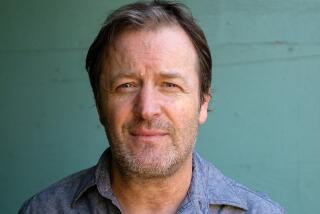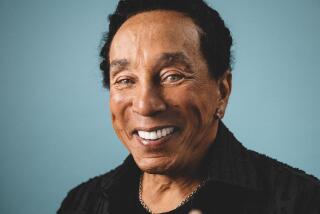Herb Jeffries dies at 100; Hollywood’s first black singing cowboy
- Share via
Herb Jeffries, who sang with the Duke Ellington Orchestra during the Swing Era and made movie history in the 1930s as “The Bronze Buckaroo,” the silver screen’s first black singing cowboy, has died. He was 100.
Jeffries died of heart failure Sunday at West Hills Hospital and Medical Center, said Raymond Strait, who had been working with Jeffries on his autobiography. Jeffries had been in declining health for some time.
Known for his rich baritone and sensitive phrasing, Jeffries was a member of the Duke Ellington Orchestra in the early 1940s when he scored his biggest hit with “Flamingo,” which sold in the millions and became his signature tune.
------------
FOR THE RECORD:
Herb Jeffries: In the May 26 LATExtra section, the obituary of Herb Jeffries, a pioneering black singing cowboy and jazz entertainer, gave his birth name as Umberto Valentino. In interviews he said his given name was Umberto Balentino. —
------------
“Jeffries’ version of ‘Flamingo’ with Duke Ellington was, and is, a jazz classic,” music critic Don Heckman told The Times in 2010. “Jeffries’ rich-toned ballad style resonated in the work of such male jazz singers as Johnny Hartman, Joe Williams and even Sammy Davis Jr. for decades after the chart-breaking success of his ‘Flamingo.’”
As the African American answer to Gene Autry, Roy Rogers and other white singing cowboys, Jeffries made a handful of low-budget westerns in the ‘30s.
They had titles such as “Harlem Rides the Range” and “The Bronze Buckaroo” and featured the tall, handsome, wavy-haired singer with a Gable-esque mustache as a dashing, white-hatted good guy in a black western outfit and riding a white horse named Stardusk.
The idea to make movie westerns with all-black casts was Jeffries’.
“Little children of dark skin — not just Negroes, but Puerto Ricans, Mexicans, everybody of color — had no heroes in the movies,” he told The Times in 1998. “I was so glad to give them something to identify with.”
He was born Umberto Valentino in Detroit on Sept. 24, 1913.
“My mother was Irish, my father was Sicilian, and one of my great-grandparents was Ethiopian,” Jeffries, who took his stepfather’s last name, told the Oklahoman in 2004. “So I’m an Italian-looking mongrel with a percentage of Ethiopian blood, which enabled me to get work with black orchestras.”
He began singing locally as a teenager before heading to Chicago, where he started touring as a singer with Earl “Fatha” Hines. In the deep South, he was struck by the number of black movie audiences viewing white cowboy pictures.
Realizing the size of the potential market, he talked Jed Buell, a white, independent B-movie producer in Hollywood, into helping out.
But finding an African American who could ride, sing, and act was difficult — until the tall, broad-shouldered Jeffries, who learned to ride on his grandfather’s dairy farm in Michigan, nominated himself.
“No way. They’ll never buy you; you’re not black enough,” the light-skinned Jeffries remembered Buell saying. Jeffries said Buell finally agreed to let him play the part but insisted that Jeffries wear makeup to darken his skin.
“Harlem on the Prairie,” billed as “the first all-Negro musical western,” was released in 1937. Among the all-black cast members were Spencer Williams, who later portrayed Andy on “Amos ‘n’ Andy” on television, and comedian Mantan Moreland, who provided comic relief.
Jeffries earned $5,000 for the film, which was shot at a dude ranch near Victorville in five days.
Each of the films that followed were produced just as fast. In later years, Jeffries would jokingly refer to them as “C-movies.” But he took great pride in them.
“To say I was the first black singing cowboy on the face of this earth is a great satisfaction,” he told American Visions in 1997.
In an era when black actors typically played subservient roles on screen, Jeffries stood out.
“Herb was a sex symbol,” New York University film professor Donald Bogle, author of “Toms, Coons, Mulattoes, Mammies & Bucks,” a history of black films, told The Times in 2003. “With his wavy hair and Clark Gable mustache, he might have been a different kind of star had America been a different kind of place.”
Three more musical westerns starring Jeffries were released over the next two years, “Two-Gun Man from Harlem,” “The Bronze Buckaroo” and “Harlem Rides the Range.”
Jeffries cashed in on his fame by making stage appearances with the Four Tones, his movie backup singers.
Touring in a Cadillac with steer horns on the front and his name in gold rope on the side, he’d do rope tricks, spin his six-shooters and sing.
While promoting his final film in Detroit in 1939, Jeffries showed up at a performance by the Duke Ellington Orchestra and was invited to sing. Ellington later asked Jeffries to join his orchestra on tour.
Jeffries, who began singing with what has been described as a luscious tenor, followed the advice of Ellington’s composer-arranger Billy Strayhorn and lowered his range to what music critic Jonny Whiteside later called a “silken, lusty baritone.”
In addition to recording with Ellington, Jeffries appeared in Ellington’s legendary all-black musical revue “Jump for Joy” in 1941. The show, featuring a 60-member cast that also included Ivie Anderson, Joe Turner and newcomer Dorothy Dandridge, ran for 12 weeks at the Mayan Theater in downtown Los Angeles.
Drafted into the Army during World War II, Jeffries sang in a Special Services company entertaining troops. After the war, he had a number of hit records, including “When the Swallows Come Back to Capistrano” and “Basin Street Blues.”
By the early ‘50s, he had moved to France and opened a popular jazz club in Paris called the Flamingo and another club in southern France. He continued to perform both in Europe and the United States and played the title role in the 1957 film “Calypso Joe,” costarring Angie Dickinson.
He returned to the U.S. in the 1960s, settling in the Los Angeles area, and made guest appearances on a number of television series over the next two decades.
In 1992, a tribute to the singing cowboys at the Gene Autry Western Heritage Museum — along with the discovery of copies of several of Jeffries’ long-lost cowboy pictures in a cellar in Texas — triggered a resurgence of interest in his movie career.
In addition to being rediscovered by the mainstream media for his role in breaking Hollywood race barriers on screen in the ‘30s, Jeffries was featured in a segment of Turner Broadcasting’s “The Untold West” and scenes from his westerns appeared in Mario Van Peebles’ 1993 movie “Posse.”
The renewed interest led him to Nashville, where he recorded “The Bronze Buckaroo (Rides Again)” for the Warner Western label in 1995.
Jeffries, whose marriages included one to burlesque legend Tempest Storm, is survived by his fifth wife, Savannah; three daughters; and two sons.
McLellan is a former Times staff writer.
More to Read
Start your day right
Sign up for Essential California for the L.A. Times biggest news, features and recommendations in your inbox six days a week.
You may occasionally receive promotional content from the Los Angeles Times.






